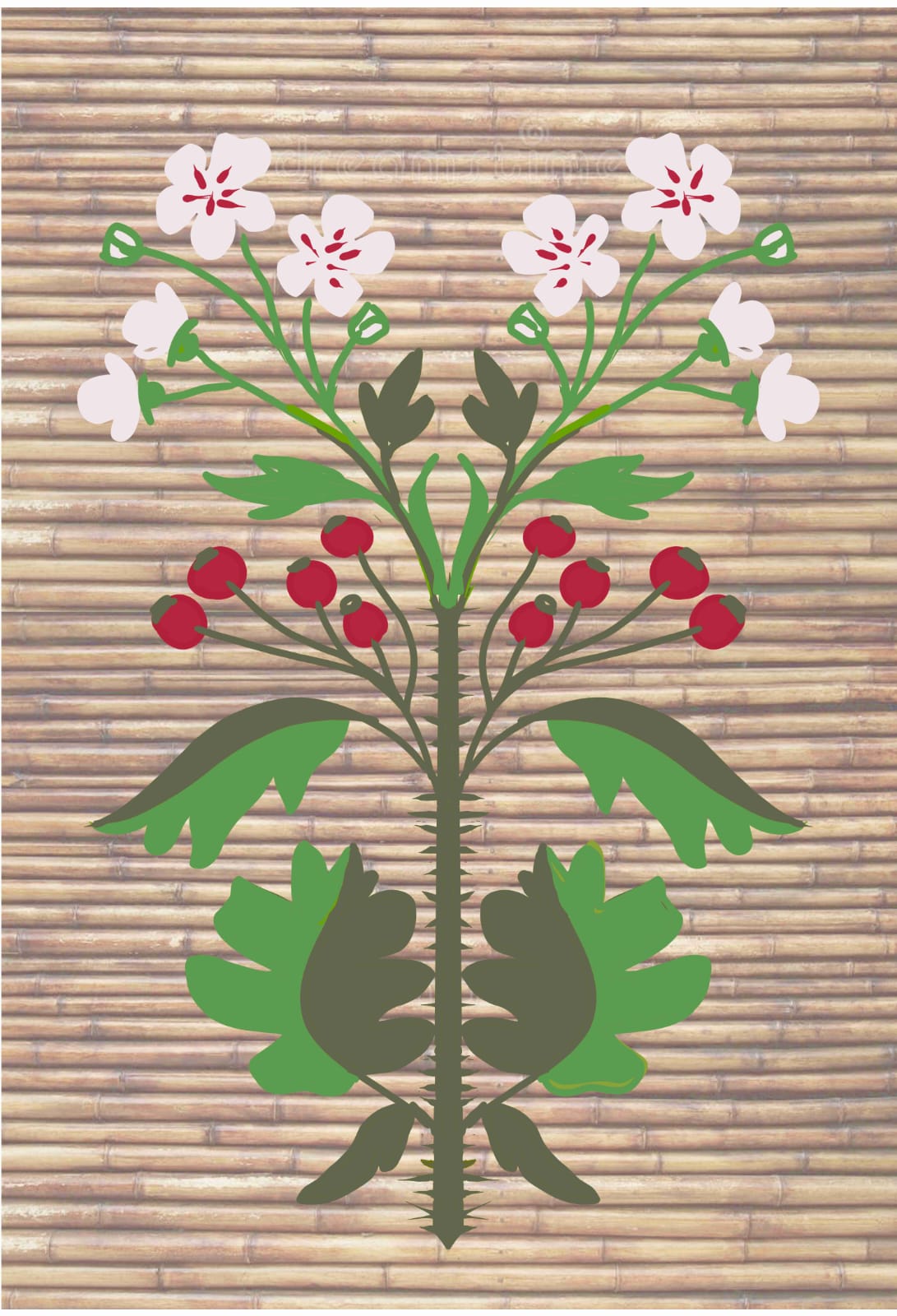‘Nettle and I, [Hawthorn], are Martian plant friends, holding boundaries, holding edges…altered states are never far away.’
Seed sistars, 2021. Voices from the Hedgerow, blog.
Hawthorn, Crataegus oxycanthoides/monogyna.
It’s Latin name, Crataegus Oxyacantha, comes from the Greek kratos, meaning hardness (of the wood), oxcus meaning sharp, and akantha meaning a thorn. Its common names include Mayflower, May Tree, Hagthorn, White thorn, Tree of Chastity, Pixie Pears, and many others. It is also known as ‘Father of the Heart’, (Conway, 2001).
Introduction:
As a framework for this study on Hawthorn, I’ll be using the seven universal themes as set out by Sharman Apt Russel in Anatomy of a Rose. Russel’s collected universal ideas provide measures against which I examine aspects of the plant. I will bring these into my own story, thus sharing my personal relationship with Hawthorn as it unfolds.
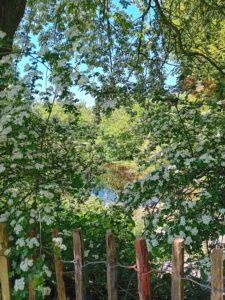 The universe tends towards complexity:
The universe tends towards complexity:
As a child I remember the overwhelming smell when the May flowers were in blossom, and then as an adult gathering them with my own children to make wine. This very particular smell was said to be ‘exactly like the smell of the Great Plague of London’, (Vickery, 2019), and ‘reminiscent of female sexual secretions’, (Graves, 1961).
The flowers are more complex than they seem however, containing proanthocyanins (flavonoids) which act medicinally, dilating and relaxing the blood vessels in the body -particularly the coronary vessels- improving
heart strength, helping to normalise blood pressure, and creating free blood flow. The flowers are bisexual, each around 10-15mm in diameter. They are set in branched, corymb clusters, blooming in swaths along the hedgerows, opening just after the leaves unfurl in mid-May. H.E. Bates describes the blossoms as ‘The risen cream of all the milkiness of May-time’. The death scent and sexual connotations have helped to link the Hawthorn to its complex symbolism, that of the circle of life: fertility, sex, birth, growth, death, and decay. And, to the three aspects of the Goddess – maiden, mother, and crone. (Conway, P. 2001). The flowers which are fertilised by carrion insects, do in fact release trimethylene, which is the same chemical odour that is given off by a decaying corpse, (Breverton, 2011).
The universe is a web of relationships:
The Hawthorn has been interwoven with human activity for thousands of years. It’s always been on the boundaries of our relationships with each other, and of the world; from our creation myths and folklore to our politics and early agricultural practices.
Interestingly the expression ‘Gathering Nuts in May’ refers to Hawthorn. The ‘nuts’ meaning knots. The wood was well known for its strength and was gathered to make tools. Wreaths and crowns were also made from the blossoms, for spring celebration rites. (Breverton, 2011). According to Robert Graves, (1961), Hawthorn, (or Uath/Huath in old Irish), was the sixth letter in the Ogham alphabet of trees. A relic of the Celtic oral tradition originally of the Druids. The word Haw means hedge, and Hawthorn was often known as Quick, Quickthorn, or even Wick or Wicken, especially in the Lancashire, Cheshire and Yorkshire area, (Vickery, 2019), because it grows fast. The German name of Hagedorn, meaning Hedgethorn, shows that from a very early period the Germans divided their land into plots by hedges. (Grieves, 1931) Hawthorn has been used for hundreds of years to protect crops and to enclose livestock because it creates an almost impenetrable natural barrier of thorns. Between the 16th and 18th centuries it was planted in the thousands by Britain’s landowners to seal off the newly created estates during the land enclosures. (Gifford, J. 2000).
The Hawthorn has an important interrelationship with other species: the haw berries provide a vital and nutritious food source for hedgerow birds (who in turn help to propagate new plants); the flowers provide an important source of pollen and nectar for insects, the leaves are grazed on by animals, and the entangled network of branches provide nesting cover and protection from the weather. (Fichtner, A & Wissemann, V, 2021).
Evidence exists of man’s use of hawthorn as a food source from as early as the late Iron Age. (Tassel M, 2008). I remember as a child both my mother and my grandmother referring to the Hawthorn as Bread and Cheese and I was taught to nibble on the leaves, to use them in salads and to eat the red
haw fruits later in the year which are high in vitamin C and D. This relationship between Hawthorn and humans has always been close. For example, field workers used to stave off hunger pangs during the day, – the haw fruit (or pome), is known to dull the appetite – so that they could work for longer. (Seed sistas, 2021).
When it’s not entangled with others as part of a hedgerow, the hawthorn tree can grow to 8m. These lone ‘Fairy trees’, often beautifully shaped by the weather, were thought of as doorways or gateways to the fairy realm. The Welsh goddess Olwin is said to have wandered an empty universe
leaving a trail of hawthorn petals where her feet had walked, and according to legend this became the milky way. (Seed sistas, 2021). The tree itself, according to Culpepper, is governed by Mars, which is said to have fiery, warlike aspects, and in magical herbalism the leaves and wood are used
to make lightening charms and protection amulets. (Cunningham, S. 1982).
The Christian church perpetuated an improving tale of the monk, Joseph of Arimathea, who allegedly put his staff into the ground at Glastonbury, (the seat of the old religion), and gave rise to the Glastonbury Thorn. The Holy Thorn miraculously flowered at Christmas as well as spring. There are nearly 300 varieties of Hawthorn throughout temperate Europe however, and it’s more likely that the Glastonbury Thorn was a Mediterranean variety which flowers twice a year. Another good example of how the Hawthorn became entangled in the suppression of an older belief system, is the introduction of the season of Lent at the time of the Spring Fertility celebrations. The expectation of abstinence during Lent effectively condemned the pagan traditions, including the May pole dancing. (Conway, P. 2001).
Although Hawthorn has been known to treat heart conditions, for centuries in folk medicine, its relationship as a specific remedy in the treatment of cardiovascular disease, goes back to 19th century, an Irish doctor called Green and his successful ‘secret’ remedy. Following his death his famous cure was revealed to be a tincture of hawthorn berries. Since then, a great deal has been written and focus is now on hawthorn’s amazing action on the heart. Some research has been undertaken, and more research is urgently needed regarding the mechanisms and actions of the complex phyto-chemicals in Hawthorn. How these constituents work together to create a ‘synergy effect’ is also something which needs to be better understood. Research that has been done, does indicate that Hawthorn remedies are more effective in early-stage heart conditions, however.
(Tassel M. 2008).
It is the high content of antioxidant flavonoids which give the berries their fiery red colour. The important balancing effect on blood pressure and the anti-inflammatory effect in the body, in turn, takes away some physical and emotional pressure, creating less fear and more courage as well.
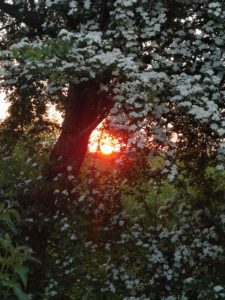 The universe tends towards symmetry:
The universe tends towards symmetry:
The Hawthorn is a deciduous shrub or tree, and part of the Rose family, whose members predominately have five petalled flowers and small fruits, or pomes. Hawthorn flowers, around 1.5 cm across, have white, or pale pink, petals, pink/purple anthers, a single style, and pink/purple tipped stamens in the centre. They have five green sepals in the shape of a star on the back of each.
The leaves are ovals, small and shiny, with 3-5 lobes in each, (like small oak leaves), and growth is alternate, often coriaceous. The wood is porous and fine grained, with distinct rings and is hard and heavy. The wood burns well on my wood burner too.
Hawthorn has a far-reaching tap root system and resprouts quickly if coppiced or grazed. It thrives in all soils, tolerates cold and exposure or salt air. The wood is flexible and is often found growing at altitude, sculpted by the wind. The plant has thorns which are around 1cm long and either grow in the bud joints, or at the ends of the shoots. The berries have a soft creamy flesh -similar to avocado – and contain a single nutlet (seed) from which the plant successfully colonises. (Fichtner, A & Wissemann, V, 2021). Hawthorn berries look like little hearts and are a good example of Paracelsus’s ‘Doctrine of Signatories’, the concept that “Nature marks each growth…according to its curative benefit.”
The universe is rhythmic:
Hawthorn is linked both with our wheel of the year -helping us to mark seasons- as well as its gentle effect on our internal human rhythms -through its action on the cardiovascular system.
I remember being told the old proverb: ‘Ne’er cast a clout before May is out.’ Meaning don’t go out without your coat, until mid-May when the Hawthorn blossom is in flower, as the weather can still be unpredictable. This is confusing until the change in our calendar is accounted for. Before the introduction of the Gregorian calendar in 1752, the flowers would have been in blossom around the beginning of our month of May to mark the beginning of Spring. Likewise, the berries ripen before the Autumn equinox to mark the year’s harvest festival.
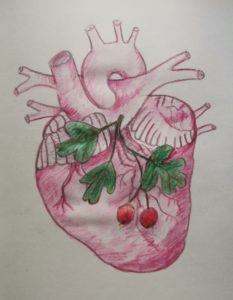 The universe tends towards self-organising systems:
The universe tends towards self-organising systems:
Hawthorn is a common shrub (or tree). It grows on scrub land, in hedgerows, forest boarders, pastures and on neglected arable land. It colonises quickly from seed and is tolerant to occasional mowing and grazing. The branches grow fast and thick and the blossom and subsequent fruit is usually prolific.
As stated previously, Hawthorn is a great balancer of the cardiovascular system. It contains pharmacologically active flavonoids that are thought to inhibit vasoconstriction and actively dilate blood vessels. Thirty-three different flavonoids have been identified in the plant, including 20 flavone and 13 flavonol derivatives. (Tassel M. 2008).
The universe depends on feedback and response:
Cardiovascular disease is currently one of the leading causes of mortality and morbidity world-wide. Helping people to achieving homeostasis is more important than ever. The Hawthorn acts on the coronary vessels which supply oxygen to the heart muscle. It strengthens heart contractions whilst also having a relaxing effect on blood vessels generally in the body,
reducing resistance and resulting in better circulation and blood flow. But it has long been regarded as the herb not only for strength of heart but as a support to the broken-hearted and the grieving.
Thus, the universe is “free” and unpredictable:
I had heard that grief, heart ache and loss can manifest in people in a great variety of ways depending on the individual. Up until my father died at the end of last year, I was a symptomless peri-menopausal sculptor. At the time he died I was artist in residence at the Yorkshire Sculpture Park. His death didn’t affect me in the emotional way I would have expected, it was physical, and, over the course of just three months I had all the worst menopausal symptoms, and more, all in one go! It was as if the grief triggered a change in my body, and then, just as suddenly, it was over.
During my art residency I had been researching the rose family – Rosenstiel having been my father’s original surname, (meaning rose stem/ rose grower). At the sculpture park I created art works inspired by the abundant blackberries, (from the rose family). It was for this reason I was drawn to
look more closely at Hawthorn, Crataegus Oxyacantha, another Rosaceae.
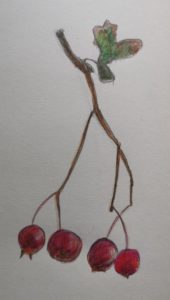 However, it wasn’t until earlier this year after the menopause symptoms had disappeared, that I was diagnosed with severe hypertension and began to really understand the power of hawthorn on the heart. For several weeks I was having my blood pressure and cholesterol levels monitored (and still am). I began taking hawthorn as a tea along with linden, cramp bark, skull cap, burdock, and nettle. The results were incredible. In four months, my blood pressure (which had regularly been 148/99) normalised, and my cholesterol levels dropped from 8.2 to 6.6.
However, it wasn’t until earlier this year after the menopause symptoms had disappeared, that I was diagnosed with severe hypertension and began to really understand the power of hawthorn on the heart. For several weeks I was having my blood pressure and cholesterol levels monitored (and still am). I began taking hawthorn as a tea along with linden, cramp bark, skull cap, burdock, and nettle. The results were incredible. In four months, my blood pressure (which had regularly been 148/99) normalised, and my cholesterol levels dropped from 8.2 to 6.6.
I completely flummoxed the doctors, and have so far managed to avoid the conventional drugs, statins, stent etc.
I thought that I had chosen Hawthorn, but I think really it chose me, and, although I hadn’t realised it at first, it was exactly the medicine that I needed. I’ve come to regard Hawthorn as the tough old father I lost, it has quite possibly saved my life.
Bibliography:
Breverton, T. (2011) Breverton’s Complete Herbal. Quercus Publishing Plc,
Conway, P. (2001) Tree Medicine. Judy Piatkus Limited
Cunningham, S. (1982). Magical Herbalism. Llewellyn Publications
Dadachanji, A. (2021). Wild Apothecary: Reclaiming Plant Medicine for All. Aeon.
Fichtner, A & Wissemann, V, (2021). Biological Flora of the British Isles: Crataegus monogyna, Journal of Ecology, published by John Wiley & Sons Ltd on behalf of British Ecological Society
https://besjournals.onlinelibrary.wiley.com/doi/epdf/10.1111/1365-2745.13541
Francis, M; Doherty, R; Patel, M; Hamblin, J F; Ojaimi, S; Korman, T M (2011). Curtobacterium flaccumfaciens Septic Arthritis following Puncture with a Coxspur Hawthorn Thorn. ASM Journals, Journal of Clinical Microbiology, Vol. 49, No. 7
https://journals.asm.org/doi/full/10.1128/jcm.00340-11
Gifford, J. (2000). The Celtic Wisdom of Trees. Godsfield Press Ltd.
Graves, R. (1961). The White Goddess. Faber and Faber Limited
Grieves, Mrs M. (1931). A Modern Herbal. Botanical.com
https://botanical.com/botanical/mgmh/h/hawtho09.html
Russel, Sharman Apt. (2001). Anatomy of a Rose: The secret life of Flowers. William Heinemann Ltd.
Seed sistas, (2021). Voices from the Hedgerow, Nettle and Hawthorn – Herbal Astrology
Seed sistas, blog The Hawthorn Tree
Seed sistas, blog, Hearty Hawthorn
Tassel M. (2008). Towards a systematic scientific approach in the assessment of efficacy of an herbal preparation: Hawthorn (Crataegus spp.) European Journal of Heart Failure 10.
Elsevier. Tree Guide UK, (2014-23)
Vickery, R. (2019). Vickery’s Folk Flora. Weidenfield & Nicolson

